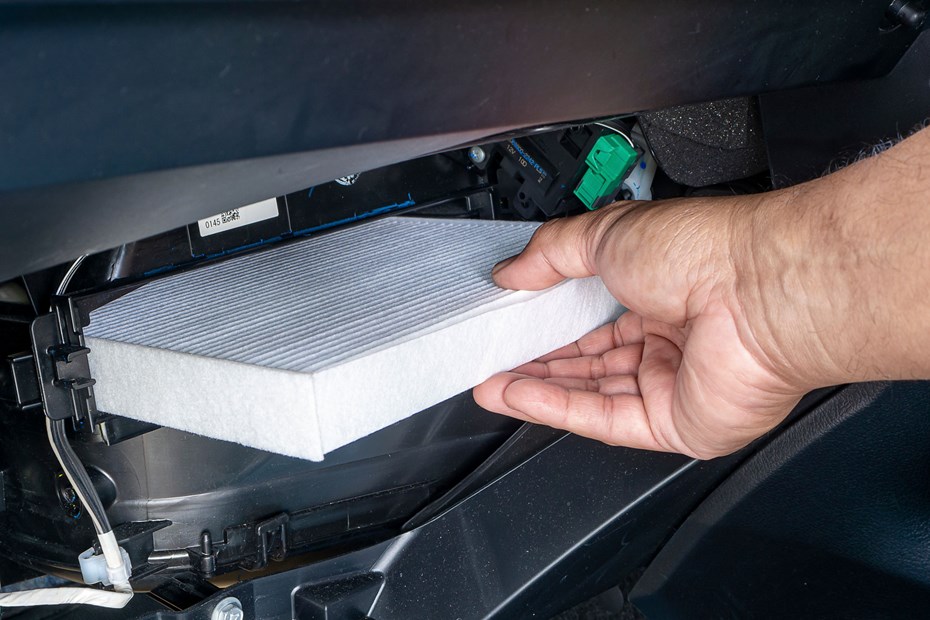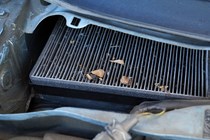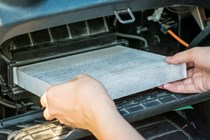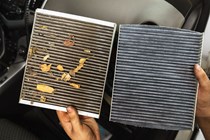A car’s cabin filter is what keeps the air coming into your car fresh and clean. It does what it says on the tin and filters the air coming into the cabin, but like all filters it can get clogged over time and will need changing. It can be done easily on your driveway with just a few basic hand tools.
The cabin air filter – also known as a pollen filter – is different in every car, but the process for changing it is rarely any different. It should be pretty easy to access unless your car is unusual or very complex – sometimes high-end luxury and sports cars have unusually difficult-to-access cabin filters but normal cars have them in a convenient place most of the time.
In this guide we’ll look at the steps you need to take to change it, but before you begin you might want to check your car’s manual to find out where yours is located. If that doesn’t help, search your make and model online and the words “cabin filter location” or similar and you should find plenty of advice on how to locate it.
What is a cabin filter?
The cabin filter in your car goes in between where the air comes into the car and the air vents in the cabin. It blocks dust, dirt, pollen and other debris from entering the car, so it’s essential for keeping the interior pleasant and clean. If you drive through a smoky or dusty area then it’s what stops all that pollution in the outside air from getting into the car.
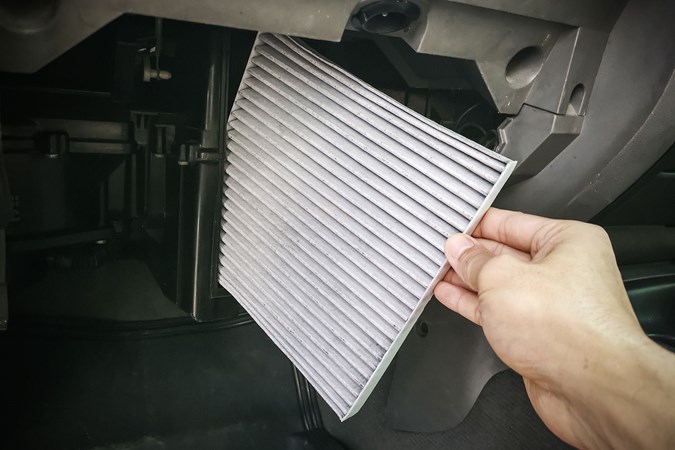
The filter is made of paper or cotton and many have extra technology such as a layer of carbon to filter the air even more effectively. They’re a rectangular shape most of the time and have a bumpy pattern that maximises the surface area for air to get through, but this also means they can get clogged with dirt easily as well – which is why they need changing every so often.
Some car manufacturers even use filters with anti-bacterial layers which can capture biological contaminants that may get past other types of filter. They also help keep the filter clean, so it’ll last longer.
Why do I need to change my cabin filter?
After a couple of years of driving the cabin filter will start to get clogged up. It’s nothing to be worried about, it’s a normal part of its operation and replacements will be readily available from any car maker. You can buy them online or call your local dealer to order a replacement.
You can tell if a cabin filter or pollen filter needs replacing if the heating or cooling isn’t working as well as it was before – it’s a sign that not enough air is getting through the filter. You might also smell a damp smell inside the car, which hints that there is mould on the filter. If that’s the case it needs changing as soon as possible since mould can be dangerous to breathe in.
Sometimes it’s not the filter that gets blocked, but the housing it sits in. If that’s the case, you should change the filter but also clean out the areas with debris around it as well using a vacuum cleaner or a cloth.
How often should I change my car’s cabin filter?
In the servicing and maintenance section of your car’s owner’s manual, there should be advice on how often to change the cabin air filter. Changing it will be part of the car’s routine servicing schedule – not necessarily at every service, but certainly fairly frequently.

If you’re not sure when your car’s cabin filter was last changed, it’s worth doing for peace of mind. A new one can cost less than £10, so you won’t lose out much if the procedure turns out to be unnecessary.
Where is the cabin filter in my car?
Your car’s owner’s manual should detail where the cabin air filter is and how to change it. If that information isn’t available, there are a few places to look for the cabin filter.
It could be behind the glovebox. If it looks like it’s built into the lid, you should be able to detach it from the dashboard and access the space behind. If not, there may be an access panel. If you see the ventilation system’s fan or blower motor, the cabin filter is probably close by. The housing will look a bit like an old-school VCR player.

Alternatively, the cabin filter may slot into the back of the dashboard centre console. You may be able access it from behind the glovebox, or by removing a panel from the dashboard, accessed by leaning into the footwell. It could also be in the car’s engine bay, in the area below the wipers.
If all else fails, searching online should turn up the answer and possibly a comprehensive guide to changing it on your car.
What tools or safety equipment do I need?
With any luck, the cabin filter in your car will be so easy to replace that you don’t need any tools at all. But we’d advise having a screwdriver, pliers, a set of Allen keys and a torch to hand just in case.
Because the filter can be clogged with all sorts of potentially harmful particles, it’s also wise to protect yourself. Some gloves, a face mask and safety glasses are a sensible precaution if you suspect mould.
Lastly, the filter housing may need cleaning out, so bring a vacuum cleaner as well. It’s worth changing the filter while also cleaning other areas of your car’s interior all at once to make the whole cabin more pleasant.
How do I change the cabin filter in my car?
The exact process for changing a cabin air filter varies from car to car, but the individual steps are broadly similar. Follow this step-by-step guide and do a bit of research on your car specifically, and you should be able to complete the job with little fuss.

1. Locate your car’s cabin filter
The cabin filter is probably located behind the glovebox, the dashboard centre console, or near the wiper mechanism at the base of the windscreen. Your car’s owner’s manual may provide the location; if not, you should be able to find it online.
You might have to remove the glovebox lid or plastic access panels to expose the filter housing. A screwdriver, socket set and pliers may be needed. Even if there are no screws or bolts to undo, there may be retaining clips that need prying open. Be careful not to damage anything. It’ll probably be quite dark where you’re working, so a headtorch could be useful, as well.
2. Remove the old cabin filter
Once you’ve accessed the filter housing, put some gloves on and remove the filter. There may be secondary cover over it to remove, or it’ll be clipped into place. There could be lots of gunk on the filter and in the housing so, if you’re working inside the car, you may want to put down some paper or plastic to protect the carpet.
You could take a picture of the old filter in place so you know how the new one should fit. There should be an arrow that shows the direction of the airflow and you need to orientate the new filter correctly for it to work properly. The old filter should just pull out of the housing; check for any retaining clips first.
Compare the old filter with the new one to make sure they match, then the old one can be binned.
3. Clean out the cabin filter’s housing
Vacuum out the filter housing to get rid of any dirt, grit and debris that’s in there. Then wipe it out with a damp microfibre cloth, ideally several times to make sure it’s absolutely clean. Make sure everything is dry before putting the new filter in.

4. Insert the new cabin filter
Check which way round the new cabin filter has to be before attempting to insert it in the housing. Then simply slide or place it in. Be firm but gentle – the filter may need some manipulation to squeeze into place. Be careful not to tear the filter element or, worse, jam it in the housing. That could turn a 10-minute job into a minor nightmare.
5. Reassemble and test the ventilation system
Clip on all the plastic covers and replace the glovebox or access panels if needed. If you’re working in the engine bay, make sure any seals are carefully replaced and check that they’re seated properly. Double check that you haven’t missed anything.
Once you’re happy everything is back in its proper place, turn on your car’s ignition, then the cabin air blower. Try every speed and setting to make sure everything is working correctly. Hopefully the air flow is stronger and odour-free.
How do I know which cabin filter I need for my car?
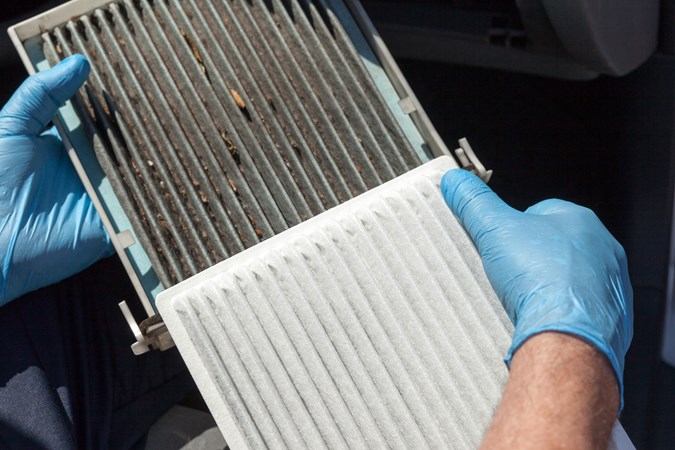
It should be pretty easy to track down the correct cabin air filter for your car. Online car parts retailers allow you to search by the registration number and type of part you’re looking for; with that information you’ll be shown all the relevant options in stock.
Alternatively, any garage, motor factor or dealership should be able to help you identify and source the correct filter. You could speed up the process by searching online for the filter’s part number.
There will usually be several options available from various brands at different price points. You also have the choice of a regular paper or cotton filter, or a more expensive activated charcoal one. The latter is a sensible choice if you’re sensitive to odours or suffer respiratory issues. You may also be able to get advanced anti-bacterial filters.
- For more advice and how-tos, check out Parkers’ ultimate guide to car care
Just so you know, we may receive a commission or other compensation from the links on this website - read why you should trust us.


